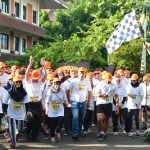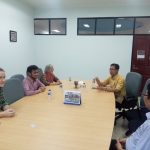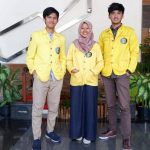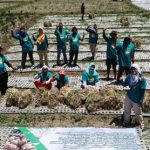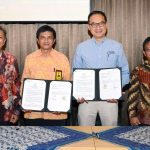Tuesday, November 19th, 2019, in the context of enhancing the mastery of science and technology as one of the keys to the success of a sustainable national development process. Several students and ILUNI FMIPA UI conducted an industrial visit to the National Nuclear Technology Agency (BATAN), Puspiptek Serpong, South Tangerang.
“By conducting this visit we want to open up, broaden our horizons, especially to the students about nuclear and its development in Indonesia”.
said Pamela C. chairman of the Alumni Association (ILUNI) to the BATAN who welcomed his entourage.
Furthermore, he explained that this visit also became a series of one-day seminar activities entitled “Nuclear Power Plant an Inevitability” which had been held earlier at FMIPA UI on November 13th, 2019.
The participants of the visit had the opportunity to enter the main building of a nuclear reactor, they were first given instructions related to the order, evacuation in emergencies, as well as a general introduction to the area of the largest nuclear reactor in Indonesia.
After the briefing, the participants were invited to visit the main building of research and production of isotopes or commonly known as liquid nuclear. They enter the nuclear reactor room, where neutrons are produced as isotopes for the use of health, agriculture, and medicine.
However, before entering the isolated room the FMIPA UI group was required to use special clothing that had been provided as a safety standard to avoid exposure to nuclear radiation.
In the room about 50 square meters, there are several parts of the controlling machine, while in the middle, there is a hole that resembles a well of about 6 meters in diameter.
It is at this well that the nuclear reactor works. Right in the middle of the hole was an aluminum rod controlling a nuclear reactor that was connected to the bottom of a 13 meter deep well. At the bottom of the well, neutrons are fired into uranium to produce new neutrons.
According to Puspitek information service officers, the heat generated when neutrons are fired into uranium can reach 30 Megawatts Thermal (MW), and that is the reason why the reactor is surrounded by pure water (H2O) and small air pressure in the space.
“When looking into the wellbore, the water looks very clear bluish with reflected light underneath,”. said Yogie, one of the student participants from the Geology undergraduate study program
The color of the water can also indicate the level of heat from the energy produced when neutrons are fired into uranium, and the hot water will automatically be discharged to waste.
Puspitek Information Service Officer also mentioned that uranium as a nuclear reactor fuel will be replaced periodically according to its use.
Before leaving the nuclear reactor room, the students of FMIPA UI must first go through a detector machine to ensure that there is no exposure to nuclear radiation.
Some participants were detected exposed to radiation. However, everything can be handled well because only their special clothing is exposed.
After leaving the room, FMIPA UI students had the opportunity to visit another building in BATAN, the Radioactive Waste Technology Center (PTLR).
When entering the building, they were immediately explained by the guide about radioactive waste management services to prevent the emergence of radiation hazards to humans and the environment, and carry out environmental monitoring to support the use of nuclear science and technology.
The guide also explained the definition of radioactive waste, types of radioactive, the origin of radioactive waste, and the process of its management. Also, the guide explained about the existing facilities in the PLTR, including evaporators, tractors, incinerators, cementation, temporary storage, and others.
The processing of liquid waste treatment can be done by evaporator, washing method, and method of processing solid waste by compaction or incinerator, namely to burn completely liquid organic waste and burning solid waste with temperatures up to 1100 degrees Celsius.
The burning capacity is 50 kg/hour and the combustion ash is immobilized with a cement matrix in an 11-liter drum container and waste storage and environmental safety.
The students seemed enthusiastic in this visit, in addition to adding insight into nuclear science and technology, advanced technology to treat radioactive waste.
“Nuclear is not dangerous if we understand the rules when using them, and use them appropriately,” said one guide at BATAN.

